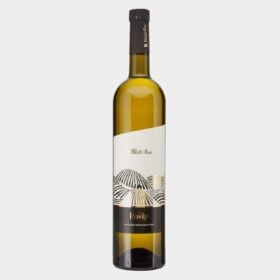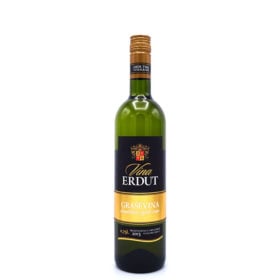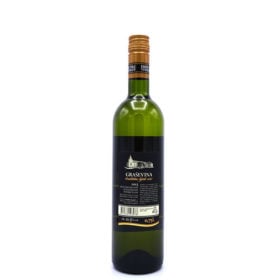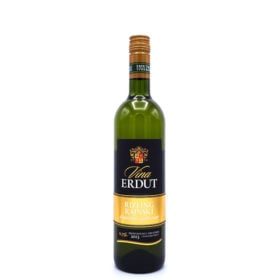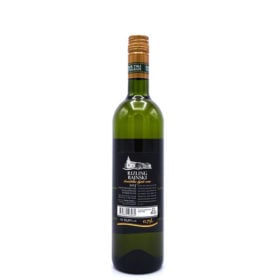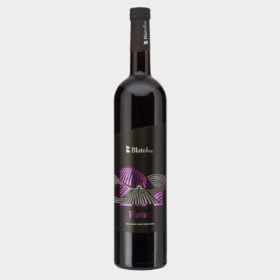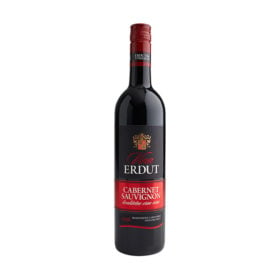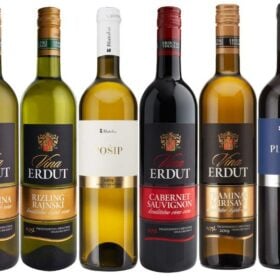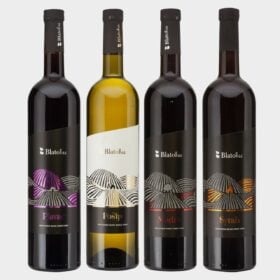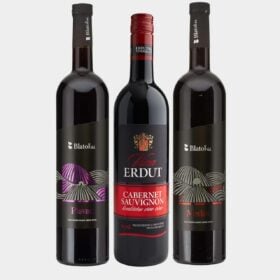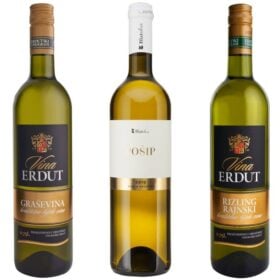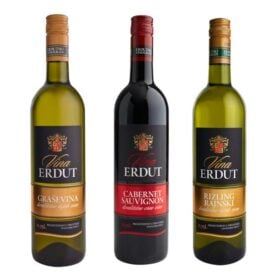One of the most talked about things when it comes to wine is whether it's a dry White wine or a sweet one White wine is. It is usually the first question asked or the first statement made. Especially when it comes to White wine goes. But what is a dry one White wine exactly?
Many people prefer dry White wine over other types of wine. Wines such as Sauvignon Blanc, Pinot Grigio and dry Riesling are produced all over the world, and wine drinkers appreciate them for their crisp flavors and the ease with which they can be paired with various dishes. You can dry all year round White wine drink, but a dry one White wine is especially refreshing during the warm summer months. With so many types of dry White wine, there is always one White wine that suits every palate.
drug White wine to define
what is dry White wine? In fact, it is a wine that is not sweet, i.e. a White wine with little sugar in wine. If you are unfamiliar with how wine is made, it basically involves sugar in the grape juice, fermentation and yeast. If a winemaker stops fermentation before the yeast has time to chew up all the sugar, sugar will remain in the wine.
Obviously, if the winemaker lets the yeast complete its mission, the result is a dry White wine or a dry red wine is. Sometimes a small amount of residual sugar can remain in dry white wines, but it is quite minimal that the wine does not taste sweet. Residual sugar is very normal and it is quite common to have residual sugars in both white and Red wine is present.
White wine is a wine that is fermented without the skins. The color may be cloudy yellow, yellow-green or yellow-gold. It is produced by the alcoholic fermentation of the uncolored pulp of grapes, which can have a skin of any color. White wine has been around for at least 4000 years. And between all these different types of white wines, there are still different characteristics.
sugar in dry White wine
Wine grapes have varying degrees of natural sugars depending on the variety (type of grape), what time of the season the grapes were harvested and the concentration level of the juices. During the fermentation process, yeast converts sugars from grape juice into alcohol. When a majority of the sugar is converted and the residual sugar is less than one percent of the wine volume (four grams of sugar per liter), the Red wine of White wine considered dry.
Wines can also be considered semi-dry if they contain a residual sugar of 12 g/l. Wines with a higher sugar content are classified as non-dry White wine or dry wine considered but as, semi-sweet or sweet wine.
Sweet and fruity are two terms that are often confused in wine terminology. A fruity wine is not necessarily a sweet wine, and the driest white or Red wine can still have multiple fruit characteristics. Fruitiness of a wine does not necessarily describe the sweetness of the wine, but rather its fruit properties.
For example, Riesling can taste like apples, or Sauvignon Blanc can have gooseberry flavors. But the same Riesling can be both sweet and dry White wine are. This is entirely dependent on the residual sugars in the wine. The less residual sugar a wine contains, the fewer calories the wine has. These wines are then labeled as dry White wine.
Crispy dry white wines?
What is a crispy dry White wine? In fact, a 'crunchy' wine refers to its refreshing character, which is due to the acidity in the wine. A fresh wine leaves the mouth refreshed, cleansed and can even be slightly acidic. They are not heavy or extremely fruity wines. Go for a Sauvignon Blanc, Pinot Grigiodry Riesling, Posip or even a Greek Assyrtiko.
Very dry wine
A very dry one White wine contains less than 4 g/l residual sugar. Therefore, they have a dry characteristic and crispness that makes them perfect for dry wine lovers.
Posip
De Posip (po-ship) grape is one of the oldest grape varieties in Southern Europe. It is one of the most famous dry white wines from Croatia. The Posip originates from the Croatian island of Korčula. The aroma complex of the Posip grapes is very rich and attractive. It has something like fresh Sauvignon notes of grass clippings and gooseberry / gooseberry blends with hints of citrus and continental fruit, as well as mineral notes. The taste is fresh with a solid higher alcohol content and contains a good coverage of the necessary acids.
The aromatic profile of Posip The grape is heavily influenced by the fermentation which gives it a toasty aroma, but it can also contain notes of Mediterranean herbs. The success of the Posip is mainly due to the fruity, mostly citrus-like, and sometimes dried candied fruits. Posip is a real Croatian dry White wine and has an intense taste and aroma.
This white grape is one of the few grapes able to withstand phylloxera (grape aphid) and still grows on its own rootstock since it was planted in the sandy soils of Korčula. Thanks to its quality features, it is only fair that Posip nowadays stands right next to so-called “super grapes” such as Sauvignon Blancs, ChardonnayPinots, Rieslings etc.
Sauvignon Blanc
This is one of the driest and crispest wines, making it a superstar for sipping or cooking. This lean, clean wine is often herbaceous or grassy with balanced acidity and underlying fruit. Sauvignon Blanc is grown all over the world. Important growing areas include the French Bordeaux, New Zealand, the Loire Valley, South Africa, Austria, California, but is also well represented in Croatia.
Grk Bijeli
Grk Bijeli or Grk is a white grape variety and is mainly found in the village of Lumbarda on the island of Korčula in Croatia. It is used to dry White wine to make. The term “grk” is derived from the word bitter (in Croatian 'gorko'. It is dry White wine from Croatia, high in acid, slightly aromatic, with hints of pine and sea salt.
The Grkvine has only female flowers. To ensure pollination, it must be planted together with another grape variety with male flowers, with a ratio about 10-20 percent, usually Plavac Mali. In addition, the Grk wine is also combined with other grape varieties to give it more body.
Albariño
Pronounced al-buh-reen-yo, this dry Spanish wine has bright sour and refreshing aromas of citrus and slightly salty notes. It is delicious with the seafood that is abundant in Spanish cuisine. The Portuguese call it Alvarinho.
Chardonnay
The Burgundy region of France is known for its excellent Chardonnay– wines. In fact, Chablis from France is a crisp, lean wine made purely from the grape. Wines from this region are rich in aromas of apples, tropical fruits, citrus and flint. New World wines such as California and Washington State are aged in new oak and tend to be toasted with vanilla flavors. The absence of oak in Chardonnay has a significant impact on flavor profiles. Without oak, bright tropical notes emerge. With oak, toasted vanilla flavors tend to dominate.
Muscadet
Pronounced musk-uh-day, this light White wine is extremely dry. Muscadet is made from Melon de Bourgogne grapes and should not be confused with Muscat or Moscato wines, which are usually neither dry nor semi-sweet. Instead, Muscadet is tart, tangy and delicious with citrus and mineral notes. This wine comes from the Loire Valley.
Torrontés
Torrontés (torr-on-tez) is a wine that is becoming increasingly popular. You will find many delicious examples from South American countries, especially Argentina. It is an aromatic White wine, which means that the wine is particularly aromatic. On the palate you will discover peach and citrus notes, along with a bright acidity and floral notes.
Semi-dry wine
A half dry White wine or half dry red wine can contain up to 12 g/l of residual sugar. This one is usually a bit sweeter than very dry ones White wine, but not so sweet that the wines are classified as completely dry White wine or as a dessert wine.
Graševina
Graševina is a fresh dry White wine with a slight pleasant aroma and a taste of honey and apple. Most popular and most drunk wine from Croatia. Besides being the most widely planted grape variety in Croatia, Graševina also the most wanted White wine. The region of Slavonia is almost a synonym for this variety, where Graševina shows the best results.
Graševina is a late harvest grape variety and, in the simplest young and fresh style, it will have a predominantly fruity, floral character with crisp acidity and medium alcohol content. It is excellent as a great start to a meal, as a chilled aperitif drink and as an addition to summer foods such as mussels, oysters, salads and of course cured meats and cheeses.
Pinot Grigio / Pinot Gris
In Italy this wine is called Pinot Grigio. In Croatia it becomes wine Pinot Sivi named. Elsewhere, notably Oregon and France, wines made from the same grape are referred to as Pinot Gris. In Germany it is called Grauburgunder. Pinot Gris from Alsace, France is a sweet one White wine and usually does not fit into the dry category White wine. dry Pinot Grigio / Gris wines are light, crisp and fruity with mineral or citrus notes. Pinot Grigio Italian style is usually the fresh, mineral version of this dry one White winewhile the French Pinot Gris style is fruity and dry.
Pinot Blanco
Pinot Blanc is a genetic mutation of Pinot Noir. In Croatia it is called Pinot Bijeli. However, it is a white wine grape grown in regions such as Germany, Austria, Italy and Alsace, France and Croatia. It has similar flavor profiles as Chardonnay, creating medium to full bodied wines with tangy acidity and notes of apples and almonds.
Riesling
Another wine grape that thrives in the cooler climates of Germany, eastern Croatia and Alsace, Riesling (ree-sling) can be a dry or sweet White wine are. The dry Riesling wines have aromas of minerals, stone fruits and apples. You can also find examples of dry Rieslings from the New World like Oregon and California.
Bogdanusa
Bogdanuša is a white grape variety, which is mainly grown on the Croatian island of Hvar, where it originated on the Stari Grad plain. Wines from this grape are usually dry white wines with a greenish yellow to golden color and from 12% alcohol.
Bogdanuša is a high yielding grape variety. The name means “gift from heaven”, and Bogdanuša wines play an important role in Croatia's religious festivals. It is usually used to make young wines from varieties that are relatively low in alcohol. In addition, this wine is often used as a cuvée (blend) wine, especially Posip and Grk.
Viognier
Viognier (vee-oh-nee) is an aromatic grape. In France's Côte-Rôtie wines, winemakers even blend a little Viognier with the Syrah to add a seductive aroma with a nose of citrus. It is a French grape that is growing in popularity around the world for its strong scented aromas and flavors of peach and honeysuckle.
Istrian Malvasia
Malvasia is the common name for a number of different or related varieties that have been cultivated by the inhabitants of the Mediterranean wine-growing regions since ancient times. Malvasia is grown even in the Canary Islands of Spain, the Portuguese Azores and on the continent of these countries. It is also produced outside Croatia in France, Slovenia, Montenegro, Albania, California and Greece. According to many, the name actually comes from Greece. However, in Croatia there are two types of Malvasia: Istrian Malvasia and the Dubrovnik Malvasia.
Istrian Malvasia is a dry White wine with between 11,5 and 13,5% alcohol. Connoisseurs describe it as a full, round and harmonious wine with great fruity and floral aromatic potential. The specific aroma is reminiscent of the scent of acacia flowers, while the predominant fruit flavors are usually those of apple, plum and apricot. The mature wine has a hint of bitter almond.
Istarska Malvazija grape produces white wines with generally stone fruit flavors of peach, apricot and apple. It is above all a fresh, mineral but strong wine with a lingering aroma and taste. Malvazija Istarska (Malvasia Istriana) is now recognized as one of the most important native Croatian varieties. The small, colorful grapes give a fresh and lively but characterful white wines. Ideal for hot summer days.
Gewürztraminer
Germany and Alsace specialize in this spicy, aromatic white. In Croatia this wine is called the Traminac or Traminac Mirisavi. There are also good wines from New Zealand, Oregon and California. Not all Gewürztraminers (guh-vurtz-tra-mee-nehr) are a dry one White wine. This grape is also popular in a sweeter, late harvest version. If you are looking for a dry White wine of Gewürztraminers, choose a German trocken or halbtrocken version or the Croatian version along the Danube. Expect floral, herbal and citrus notes in this wine. Don't want dry Gewürztraminer but something special, you can also go for a dessert wine, or an ice wine from the Gewürztraminer choose.
Maraština
Maraština (also known as Malvasia Lunga Bianca) is a light-skinned grape variety grown along the coast in the Primorska region of Croatia, where it is used to make a variety of styles, including dry White wine, but also sweet and sparkling wines.
Grüner Veltliner
Austria specializes in this peach-colored wine with undertones of pepper and spice. Once the grapes are harvested when they are less ripe, citrus – especially lime – is the predominant flavor. The later in the season the grapes are harvested, the less citrus notes you will find in the wine, and ripe grapes yield wines with peach notes. This originally Austrian grape can also be found in Croatia, especially in the north-east of Croatia, along the Danube River, the grape is doing well.
Champagne and sparkling wine
Champagne (and sparkling wines outside France) is also a type of dry White wine. For champagne and sparkling wine, it gets even more confusing because of the terminology. The confusion is actually in the terms “Brut” and “Extra Dry”. Brut is actually the driest of the two, which seems odd given that Extra Dry – because of the term – appears to be the driest, but it isn't. Brut has sugar levels between 0-1,5 percent. Extra dry is somewhere between 1,2 and 2,4 percent. The term Brut is actually corrupted French for brutal, and refers to the sugar level. Stranger, but weirder things have been done in the wine industry! While many champagnes are dry, the region has its own sweetness rating. An overview of the different types of dry Champagnes:
- Extra Brut has less than 0,6 percent residual sugar and is guaranteed to be a drug White wine.
- Brut contains less than 1,5 percent residual sugar.
- Extra Sec has 1,2 percent to 2 percent. It is a semi-dry wine.
- Sec has 1,7 percent to 3,5 percent residual sugar.
- Demi-Sec contains 3,3 percent to 5 percent residual sugar.
- Doux contains 5 percent or more residual sugar.
Which wines are considered dry?
Any wine between 0 and 1,3 percent residual sugar is considered “dry”. Much of the red and white wines that are not considered dessert wines are not labeled with the term "dry" at all. In fact, there is no legal requirement to state the residual sugar percentage on the label. If you like your favorite bottle Chardonnay of Cabernet Sauvignon you may not know exactly what the residual sugar level is, but you can bet it will be dry wine.
Other countries
In many wine countries, almost the same rules apply regarding which wines are considered dry. For a table wine and the (cheaper) bottles of wine from the supermarket, the term "dry" will often not be on the label. Riesling and Gewürztraminer can usually be dry or sweet in many countries (unless you are talking about specific sweeter wines like Sauternes or Muscats). However, in Germany they have terms for their Riesling that mean dry, dry, sweet and then one for super sweet:
- Kabinett is the lowest level of sweetness
- Spätlese means dry or late picked
- Auslese which is even sweeter
- Berenauslese is very sweet
- Trockenbeerenauslese is considerably sweet, just like honey
In Croatia, almost all bottles of wine with the quality class “Kvalitetno vino” and “Vrhunsko vino” state whether they are dry wine or sweet wine. This is often not applicable to the cheaper bottles of table wine. Table wine is referred to as “stolno vino” in Croatia. An overview with the meanings in Croatian:
- drug White wine: suho bijelo vino
- semi-dry White wine: polusuho bijelo vino
- semisweet White wine: poluslatko bijelo vino
- sweet White wine: slatko bijelo vino
Label on the wine bottle
Now things get a bit more confusing when you buy wine varieties that can be "dry", "semi-dry", "semi-sweet" and "sweet". If you are a fan of Riesling and Gewürztraminer, then it is useful to look at the label to make sure whether it is sweet wine or dry wine. If you buy one of these wines, you may see something labeled as "dry" or even something with the specific residual sugar level.
Wine food combination
Ready to try some great dry white wine pairings? Keep the following in mind, although there are no hard and fast rules, you can use them as rules of thumb:
- Crispy dry white wines such as Sauvignon Blanc pair well with light, bright dishes such as the lemon fish halibut.
- Sauvignon Blanc is also the ideal wine to combine with a salad, vegetables. But also with strong notes of herbs, especially dill or basil.
- Oak wines with roasted flavors as you put them in Chardonnay would go well with rich, fatty foods, such as lobster with butter sauce or fettuccine Alfredo.
- crunchy White wine such as Riesling, Torrontés, Viognier or Gewürztraminer hold up well to spicy foods, such as Asian food.
- Champagne and sparkling white wines pair well with salty or umami-flavored foods.
- A fruity white like Pinot Gris works with delicately flavored foods, such as shellfish.
- Albariño, with its subtle salty taste, is very tasty with raw fish such as sashami.
Cooking with wine
Many recipes do not specify the specific variety of wine, but instead call for a "dry" White wine“. So which wine should you use?
- Use a wine with an intense flavor, such as a Posip or a dry one Chardonnay. A dry vermouth or a dry sherry in buttery or creamy sauces and stews such as fettuccine Alfredo or mushroom risotto.
- Combination for Bogdanuša and Graševina include Seafood Stew (bread), Salt and Pepper Squid, Turkey Sandwiches.
- Grk Bijeli is best combined with steamed mussels with fresh herbs or baked sea bass with risotto.
- Use a lighter-toned wine for lighter flavored dishes such as a beurre blanc sauce or a spring vegetable risotto. Pinot Gris is a good choice here.
- The Istrian Malvasia is easy to combine with a variety of dishes, so think of everything from salads to chicken or pasta dishes.
- For seafood, consider a sour, dry white with citrus notes like Albariño.
- For dishes that prefer herbal or vegetable flavors or that are very light. Then choose a spicy dry White wine like the Gewürztraminer.
Proper White wine how we can help your
Don't be intimidated by the term "dry". Although dry White wine isn't sweet, most are very accessible. They are especially delicious when cooled to the right temperature. And best when served with dishes that complement their flavors and aromas. If you are new to wine, seek expert advice from the restaurant staff, contact us, or read our article “What is the best wine for a novice wine drinker?".
En Red wine than?
There are many different types Red wine, but some of the most popular are Cabernet Sauvignon, Blaufränkisch / Frankovka, Merlot, Plavac Mali, Teran en Pinot Noir. Cabernet sauvignon is a full-bodied wine with an aroma of blackberries and currants. Merlot is a softer, fruitier wine, while pinot noir a light wine with flavors of cherry and strawberry. Whatever your preference, there is sure to be one Red wine that you like!
- Original price was: 19,98. 13,99Current price is: 13,99. Add to Cart


